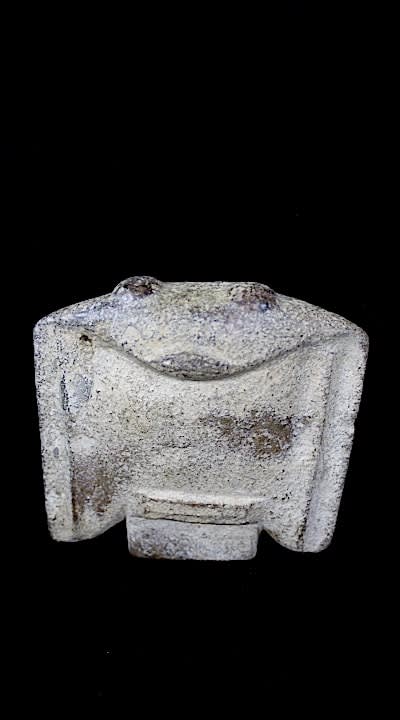Neolithic Stone Bat / Snake / Fish, 4500 BCE - 3500 BCE
The Neolithic period, which began in China around 10.000 B.C. and concluded with the introduction of metallurgy about 8.000 years later, was characterised by the development of settled communities that...
The Neolithic period, which began in China around 10.000 B.C. and concluded with the introduction of metallurgy about 8.000 years later, was characterised by the development of settled communities that relied primarily on farming and domesticated animals. In China, as in other areas of the world, Neolithic settlements grew up along the main river systems. Those that dominate the geography of China are the Yellow River (central and northern China) and the Yangzi (southern and eastern China).
A distinctly Chinese artistic tradition can be traced to the middle of the Neolithic period, about 4000 B.C. Two groups of artifacts provide the earliest surviving evidence of this tradition. It is now thought that these cultures developed their own traditions for the most part independently, creating distinctive kinds of architecture and types of burial customs, but with some communication and cultural exchange between them.
The first group of artifacts is the painted pottery found at numerous sites along the Yellow River basin, extending from Gansu Province in northwestern China to Henan Province in central China. The culture that emerged in the central plain was known as Yangshao. Yangshao painted pottery was formed by stacking coils of clay into the desired shape and then smoothing the surfaces with paddles and scrapers. Pottery containers found in graves, as opposed to those excavated from the remains of dwellings, are often painted with red and black pigment. This practice demonstrates the early use of the brush for linear compositions and the suggestion of movement, establishing an ancient origin for this fundamental artistic interest in Chinese history.
The second group of Neolithic artifacts consists of pottery and jade carvings from the eastern seaboard and the lower reaches of the Yangzi River in the south. The gray and black pottery of eastern China is notable for its distinctive shapes, which differed from those made in the central regions and included the tripod, which was to remain a prominent vessel form in the subsequent Bronze Age. While some pottery items made in the east were painted (possibly in response to examples imported from central China), potters along the coast also used the techniques of burnishing and incising. These same craftsmen are credited with developing the potter’s wheel in China.
This stylised stone sculpture of a bat / snake / fish dates from this distant time. The stone is rendered in a relatively flat square with a prominent “M” shape that can either be interpreted as the contracted wings of a bat, the broad head of a snake resembling a cobra, or a flat fish. Two eyes protrude from above the “M,” while a two-tier rectangular panel sits in line with the two eyes at the base of the “M.”
A distinctly Chinese artistic tradition can be traced to the middle of the Neolithic period, about 4000 B.C. Two groups of artifacts provide the earliest surviving evidence of this tradition. It is now thought that these cultures developed their own traditions for the most part independently, creating distinctive kinds of architecture and types of burial customs, but with some communication and cultural exchange between them.
The first group of artifacts is the painted pottery found at numerous sites along the Yellow River basin, extending from Gansu Province in northwestern China to Henan Province in central China. The culture that emerged in the central plain was known as Yangshao. Yangshao painted pottery was formed by stacking coils of clay into the desired shape and then smoothing the surfaces with paddles and scrapers. Pottery containers found in graves, as opposed to those excavated from the remains of dwellings, are often painted with red and black pigment. This practice demonstrates the early use of the brush for linear compositions and the suggestion of movement, establishing an ancient origin for this fundamental artistic interest in Chinese history.
The second group of Neolithic artifacts consists of pottery and jade carvings from the eastern seaboard and the lower reaches of the Yangzi River in the south. The gray and black pottery of eastern China is notable for its distinctive shapes, which differed from those made in the central regions and included the tripod, which was to remain a prominent vessel form in the subsequent Bronze Age. While some pottery items made in the east were painted (possibly in response to examples imported from central China), potters along the coast also used the techniques of burnishing and incising. These same craftsmen are credited with developing the potter’s wheel in China.
This stylised stone sculpture of a bat / snake / fish dates from this distant time. The stone is rendered in a relatively flat square with a prominent “M” shape that can either be interpreted as the contracted wings of a bat, the broad head of a snake resembling a cobra, or a flat fish. Two eyes protrude from above the “M,” while a two-tier rectangular panel sits in line with the two eyes at the base of the “M.”
